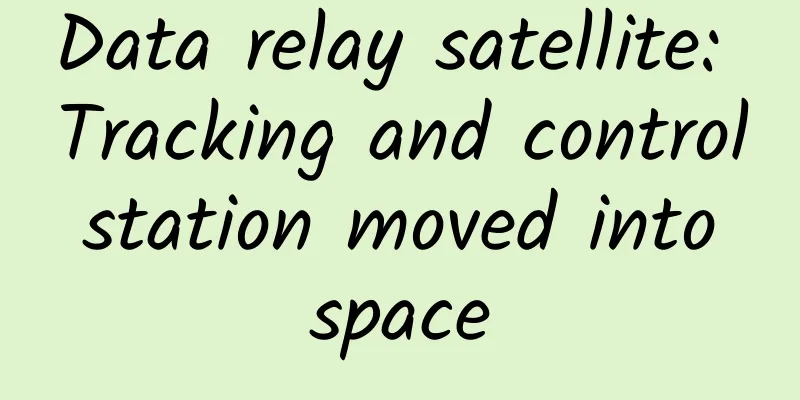Data relay satellite: Tracking and control station moved into space

|
On July 13, 2022, Tianlian-2-03 was successfully launched at the Xichang Satellite Launch Center. Tianlian-2-03 will realize global networking operation with Tianlian-2-01 and 02, and can meet the global coverage of medium and low orbit spacecraft and provide 24-hour uninterrupted communication. Long March 3B launches Tianlian-2 satellite Construction of space-based tracking and control stations The tracking and data relay satellite system is a system that provides data relay, continuous tracking, and measurement and control services between spacecraft in medium and low orbits, and between spacecraft and ground stations. Relay satellites, also known as "satellites of satellites", are a relatively small but very important member of the satellite family. They are generally located in geostationary orbits, covering user spacecraft from top to bottom. In the early days of the space age, people discovered that due to the curvature of the earth and the rectilinear propagation characteristics of radio waves, a single ground station could only "see" the satellite 2% to 3% of the time during a low-orbit satellite's flight around the earth, and the orbital arc and communication time for measurement and control were very short. To overcome this problem, people have expanded the measurement and control network and extended the real-time measurement and control time of spacecraft by building ground stations, survey ships and aircraft, but this is very costly and the effect is mediocre. For a satellite with an orbital altitude of 300 kilometers, in order to achieve 100% coverage, more than 100 reasonably distributed ground stations must be built around the world, and many of them must be located abroad or on the high seas. As humans enter space, providing real-time communication between manned spacecraft and ground command centers has become the key to the safety of astronauts and the success of manned flight missions. It is difficult to meet the needs by simply expanding the ground measurement and control network. In order to fundamentally solve the problem, people proposed the concept of relay satellite system, moving the measurement and control station into space to provide real-time measurement and control and data relay services for spacecraft. A single relay satellite in geostationary orbit can observe most spacecraft in low-Earth orbit, and a dual-satellite network can basically cover the entire medium and low orbit airspace. Relay satellites solve the problem of low coverage of ground measurement and control networks at a lower cost and with fewer ground stations. They can transmit information to "invisible" users of ground-based measurement and control, provide tracking and measurement services for spacecraft, and undertake communication and data transmission relay services, thereby greatly improving the use efficiency and emergency response capabilities of spacecraft. As humanity's exploration of the solar system continues to deepen, probes flying to the moon and Mars will require uninterrupted measurement, control and data feedback support. It will also be necessary to deploy dedicated lunar, Martian and Earth data transmission relay satellites to provide measurement, control and communication support for deep space exploration missions. Spacecraft efficiency multiplier Relay satellites integrate multiple functions such as tracking, measurement and control, and data relay, and are the hub of space information transmission. The data relay satellite system generally includes two geostationary orbit satellites, a ground terminal station, and equipment on user spacecraft. User spacecraft sends telemetry data, detection data, voice, video and other information to the relay satellite through S and Ka band intersatellite links. The relay satellite forwards it to the ground station in the Ku band for data processing. Relay satellites have many advantages. First, they greatly increase the orbital coverage of user spacecraft. Using two satellites and one ground station, they can cover 85% of the orbital segments of spacecraft at an altitude of 200 kilometers and 100% of the orbital segments of spacecraft at an altitude of 1,200 kilometers to 12,000 kilometers, greatly improving the timeliness of spacecraft measurement and control and data transmission, and improving the signal transmission and interaction capabilities between satellites and the ground, striving to promptly detect spacecraft anomalies and eliminate faults. Relay satellite network covers the entire orbit For manned space missions, relay satellites can ensure uninterrupted communication with astronauts, monitor the working conditions of instruments and personnel at any time, and control spacecraft at any orbital position, greatly enhancing the flexibility of astronaut activity planning. For example, after the launch of Tianlian-1-01, the measurement and control coverage of Shenzhou-7 spacecraft increased from 18% to 50%. After the launch of Tianlian-1-02 and 03, my country has achieved 100% orbital coverage of medium and low-orbit spacecraft. The second is to achieve centralized management of spacecraft. Relay satellites are equipped with multiple high-gain antennas, with large system capacity and high availability. They can serve multiple user spacecraft and manage various types of spacecraft. Spacecraft covering the space segment are all measured and controlled through the relay satellite system ground station, which is conducive to the standardization of measurement and control services and measurement and control equipment on spacecraft. Third, the data transmission rate is high. The data transmission capacity of the relay satellite to the user target and the total transmission rate to the ground can reach the gigabit/second level. Moreover, the data transmission path is mainly vacuum. No matter where the user spacecraft runs, the relay satellite can transfer data to the ground station, reducing the intermediate transmission links, with higher reliability and better quality. Fourth, it is economical. A small number of relay satellite systems can replace a large number of ground stations used for tracking and controlling medium and low-orbit user spacecraft, especially overseas stations and measurement ships, and also reduce the long-distance communication between ground-based sites. It is precisely because of these significant advantages that data relay satellites have become an indispensable and important space-based infrastructure for major space powers. The United States, Russia, Japan, ESA, China and other countries have successively established relay satellite systems, playing an important role in space activities. Overseas Development Overview The United States launched its first tracking and data relay satellite TDRS-1 in 1983 and completed the construction of the first generation of data relay satellite system in 1995. The ground facilities are mainly composed of White Sands Station, Guam Station and Goddard Space Flight Center. The space-based facilities include 6 in-orbit satellites, and the coverage rate of measurement, control and communication orbits for low-orbit spacecraft reaches 100%. The US space shuttle releases the world's first relay satellite TDRS-1 Subsequently, the United States continued to deploy the second and third generation data relay satellite systems. The performance configuration of the second generation system is basically the same as the first generation, and the intersatellite link transitions from the Ku band to the Ka band. The third generation system has improved and upgraded the satellites and ground facilities. The satellites use more advanced satellite platforms and propulsion systems, with more powerful performance and higher data transmission rates. The ground system has been upgraded with software and hardware replacement, and has the characteristics of flexibility, scalability and upgradeability. The United States has built the world's most widely used, largest and most powerful in-orbit relay satellite system, which mainly provides S, Ku and Ka band relay measurement, control and data transmission services for users of medium and low-orbit satellites, the International Space Station, aircraft, ships, ocean buoys, etc. Russia's ray relay satellite system was built in 1982 and the deployment of the first-generation constellation of three satellites was completed in 1989. It provides measurement, control and data transmission support for low-orbit satellites, the Mir space station, the Soyuz spacecraft and the early Salyut space station. Russian relay satellite After 1990, Russia began to develop the second generation of relay satellites, which had basically the same configuration and functions as the first generation system, but only launched one satellite. In 2009, Russia began to develop the third generation of relay satellites, and completed the deployment of three satellites by 2014. The third generation system added S-band intersatellite links and payloads for receiving GLONASS satellite signals, which can achieve comprehensive expansion applications with the GLONASS system. ESA began developing an experimental data relay satellite in 1989 and successfully launched it in July 2001. It is mainly used to verify intersatellite microwave and optical communication technologies, and to provide data relay services for European cargo spacecraft and the International Space Station rendezvous and docking missions, Earth observation satellites, polar-orbiting platforms and other scientific satellites. ESA Data Relay Satellite In 2008, ESA began developing the European Data Relay Satellite EDRS system, which consists of three satellites EDRS-A, EDRS-C, and EDRS-D and corresponding ground stations. It is the world's first practical space high-speed laser relay system. However, neither EDRS-A nor EDRS-C are independent satellites. EDRS-A was launched as an independent payload on the European communications satellite Eutelsat9B in 2016. EDRS-C was launched in 2019 with other communications payloads. EDRS-D is expected to be launched in 2025. Japan launched a data relay and tracking satellite in 2002 to provide measurement, control and data relay services for exploration satellites, the International Space Station and Japan's Hope Experiment Module. The satellite utilization rate reached 99% and it was retired in 2017. To meet the demand for higher relay rates, Japan will launch a laser data relay satellite at the end of 2020. It has the characteristics of high reliability, miniaturization and high data transmission rate, and its performance has reached the world's advanced level. Key technologies that need to be overcome The relay satellite system is a hub for space information sharing and an efficient space-based information network infrastructure, and is a multiplier for spacecraft. Judging from the development of various countries, the relay satellite system plays a prominent role and has an important position, but compared with other satellite fields, it has developed relatively slowly and has a small number. Only a very small number of countries are capable of developing and building the system, because relay satellites have unique key technologies and difficulties. To establish an intersatellite transmission link between a relay satellite and a user spacecraft, the first thing to do is to solve the technical problem of onboard closed-loop capture and tracking. The relay satellite antenna has a large gain and a narrow beam (0.15 to 0.3 degrees), and it is necessary to complete the capture and tracking of the target signal during the high-speed flight of the user spacecraft. However, in order to simplify the system design, user spacecraft usually do not have beacons, but only data transmission signals; due to different functional positioning, the data transmission rate, modulation method, bandwidth, signal level and Doppler shift of each user spacecraft vary greatly; in addition, the antenna size and transmission power of the user spacecraft are very limited, which makes it extremely difficult for the relay satellite to capture the target signal. The relay satellite has a high data transmission rate and high antenna gain, which requires the antenna to have extremely high electrical dimensions (actual dimensions/working wavelength). At the same time, the shorter the working wavelength, the higher the shape accuracy of the antenna reflector. For example, for a Ka-band antenna, if the antenna gain loss caused by its shape error is required to be less than 0.5 decibels, the shape error of the main reflector of the antenna must be less than 0.3 mm. This not only includes the processing error, but also the deformation of the antenna reflector caused by the extreme environment in space. It can be said that the multi-band precision tracking antenna for relay satellites is currently the most difficult satellite-borne antenna to develop. When the relay satellite is in orbit, the large single-site antenna is in a state of motion with a complex trajectory and changing speed. Due to the serious dynamic coupling between the satellite and the moving antenna, and the fact that the antenna itself is a nonlinear and flexible structural system, it is necessary to master high-precision composite control technology in order to enable the extremely narrow-beam antenna to complete the capture and tracking mission of the user spacecraft. In addition, high-frequency box thermal control design technology with extremely large external heat flow changes, extremely wide-band Ku/Ka band transponder technology, and high-performance antenna driving technology are all key technologies that need to be solved by relay satellites. For user spacecraft, if they want to establish a communication connection with a relay satellite, they need to be equipped with a dedicated relay terminal that works in the corresponding intersatellite link frequency band. The antenna of the user spacecraft must have the ability to track the relay satellite and provide a certain equivalent isotropic radiated power and quality factor according to the data transmission rate requirements in order to establish a communication link with the relay satellite. Broad prospects for development and application Relay satellites provide space-based measurement, control and data relay services for user targets such as manned spaceflight, satellites, and launch vehicles, and have broad development and application prospects. In terms of manned space flight, relay satellites provide space-based measurement and control and data relay transmission services for space stations and spacecraft in orbit, provide forward and return images, voice, etc. for the entire flight of spacecraft, and support the daily operation of space stations. In terms of satellite applications, relay satellites provide long-term, stable and reliable space-based data transmission and measurement and control services for medium and low-orbit satellites such as remote sensing and mapping, and transmit data back to the ground in a timely manner to improve application efficiency. During rocket launch missions, relay satellites expand the coverage of rocket launch measurement and control, make up for the blind spots of land- and sea-based measurement and control, and transmit key rocket-borne telemetry data. As the application scope of the relay satellite system continues to expand, the user types have gradually expanded from space-based spacecraft to sea, land, air and other fields. The scale of routine relay missions and the number of service targets have increased rapidly year by year, and the mission types have developed towards diversification and systematization, which has put forward higher requirements on the transmission rate, coverage area, and access real-time performance of data relay services. On the one hand, the resolution of remote sensing satellites is constantly improving, and long-term manned spacecraft such as space stations generate a large amount of scientific experimental data every day, requiring relay satellites to provide higher data return rates. On the other hand, interstellar probes flying to the moon, Mars, etc. require continuous measurement, control and communication support, requiring the deployment of dedicated relay satellites to expand deep space long-distance relay capabilities. In addition, future spacecraft will adopt more autonomous management and autonomous flight modes. In the absence of ground measurement and control, high-precision navigation data will be received through relay satellites to achieve self-real-time high-precision orbit determination and orbit control of spacecraft. Schematic diagram of the Earth-Moon communication relay satellite Faced with new demands, major space powers have actively promoted the replacement and upgrading of relay satellite technology, developed working frequency bands towards high frequencies, and began to adopt laser communication technology to greatly increase data transmission rates; satellite systems have developed in the direction of decomposition and specialization, with the United States adopting a small satellite constellation and Europe adopting a combination of dedicated satellites and onboard payloads to build a more flexible and diverse relay satellite system and improve system flexibility; user terminals have developed in the direction of miniaturization, intelligence, low power consumption and high reliability to meet a more flexible end-to-end data interaction mode; artificial intelligence technology is combined with software radio technology to increase the data throughput of the relay satellite system and the flexibility of operation and maintenance control, further improving system performance. Relay satellite verifies laser transmission As the backbone infrastructure for high-speed transmission of space information and a spacecraft efficiency multiplier, relay satellites will play an increasingly significant role in aerospace and other applications. Their broad prospects show the strong vitality of this satellite field and will make greater contributions to human exploration of the universe. |
<<: Are these “mysterious circles” in the desert really the work of aliens?
Recommend
Google and Apple both failed! Talk about the bugs in Android 8 and iOS 11
With WP officially announcing its defeat, Android...
How to avoid pitfalls when promoting on Xiaohongshu? Xiaohongshu marketing promotion guide!
At present, the hottest brand marketing and promo...
Tik Tok Operation: The content code behind Tik Tok’s popularity!
What’s the secret behind Tik Tok’s popularity? Ti...
How much does it cost to develop the Mudanjiang Hotel mini program? How much is the price for developing Mudanjiang Hotel mini program?
WeChat Mini Program is an application that users ...
A practical video tutorial on a big data project titled "Billion-level traffic collection and monitoring"
Introduction to the content of a practical video t...
Apple quietly pushes the first beta version of iOS 14.7: iOS 14.6 will soon be released
This Tuesday, the iOS 14.6 RC candidate version, ...
I have seen 1,000 marketing promotion cases, why are they all ineffective?
In the circle of friends and subscription list of...
Promotion account structure diagram, how to build a promotion account structure?
The account structure of search promotion consist...
The longest train in China runs every 12 minutes on average.
Have you seen the longest train in China? Count t...
What are machine learning and deep learning? Faizan Shaikh will help you answer
Abstract: This article introduces the definitions...
Do you know the first river in our country named after a poem?
Qishui soup, Gradually the carriage curtains and ...
From 0 to 1, how to plan your own promotion channels?
As a newbie in the operation circle, I still don’...
Can dyeing rhino horns and ivory pink prevent poaching?
Recently, a story has been circulating on the Int...
Operational analysis: Lian Coffee’s “online takeaway + social fission”!
Even the fission of coffee makes me panic. Not lo...
Summary of 7 commonly used sorting algorithms in Java
I have been free for a while, so I took some time...









